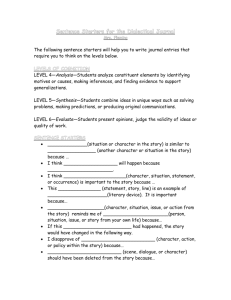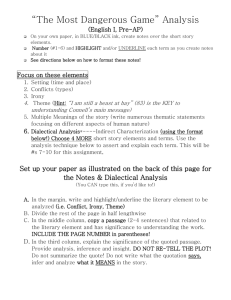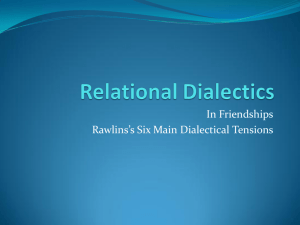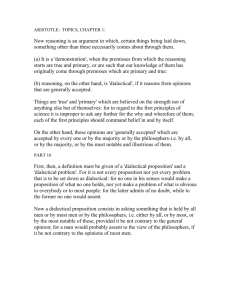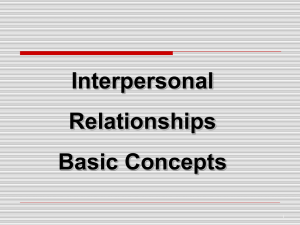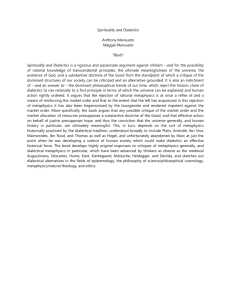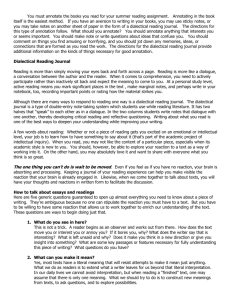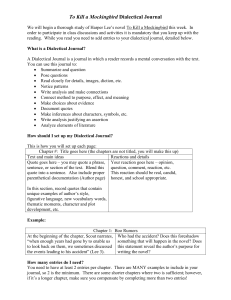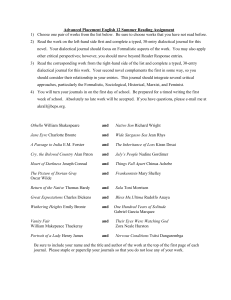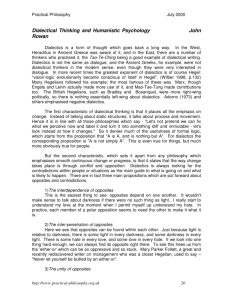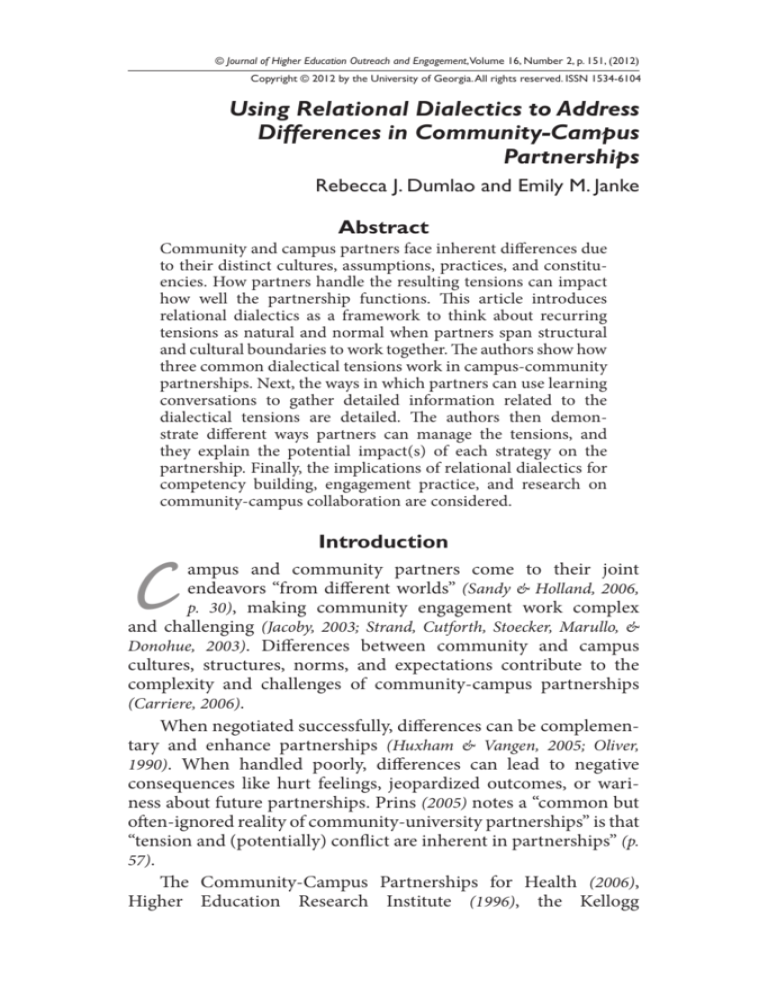
© Journal of Higher Education Outreach and Engagement,Volume 16, Number 2, p. 151, (2012)
Copyright © 2012 by the University of Georgia. All rights reserved. ISSN 1534-6104
Using Relational Dialectics to Address
Differences in Community-Campus
Partnerships
Rebecca J. Dumlao and Emily M. Janke
Abstract
Community and campus partners face inherent differences due
to their distinct cultures, assumptions, practices, and constituencies. How partners handle the resulting tensions can impact
how well the partnership functions. This article introduces
relational dialectics as a framework to think about recurring
tensions as natural and normal when partners span structural
and cultural boundaries to work together. The authors show how
three common dialectical tensions work in campus-community
partnerships. Next, the ways in which partners can use learning
conversations to gather detailed information related to the
dialectical tensions are detailed. The authors then demonstrate different ways partners can manage the tensions, and
they explain the potential impact(s) of each strategy on the
partnership. Finally, the implications of relational dialectics for
competency building, engagement practice, and research on
community-campus collaboration are considered.
C
Introduction
ampus and community partners come to their joint
endeavors “from different worlds” (Sandy & Holland, 2006,
p. 30), making community engagement work complex
and challenging (Jacoby, 2003; Strand, Cutforth, Stoecker, Marullo, &
Donohue, 2003). Differences between community and campus
cultures, structures, norms, and expectations contribute to the
complexity and challenges of community-campus partnerships
(Carriere, 2006).
When negotiated successfully, differences can be complementary and enhance partnerships (Huxham & Vangen, 2005; Oliver,
1990). When handled poorly, differences can lead to negative
consequences like hurt feelings, jeopardized outcomes, or wariness about future partnerships. Prins (2005) notes a “common but
often-ignored reality of community-university partnerships” is that
“tension and (potentially) conflict are inherent in partnerships” (p.
57).
The Community-Campus Partnerships for Health (2006),
Higher Education Research Institute (1996), the Kellogg
152 Journal of Higher Education Outreach and Engagement
Commission (2001), and Wingspread meetings (Torres, 2000)
have all established guidelines for community-campus partnerships. Each encourages partners to focus on trust, mutual respect,
reciprocity, common interests, regular communication, and longterm sustainability when working together. Despite these valuable
guidelines, however, precise processes for collaboration are not well
understood and remain a “black box” (Thomson & Perry, 2006).
Tensions in Boundary-Spanning and
Collaboration
Collaboration across community and university “worlds”
requires partners to span physical, relational, psychological, structural, and cultural boundaries (Hayes & Cuban, 1997; Janke, 2008;
Sandy & Holland, 2006). Faculty and community members must
span boundaries to form and maintain partnerships for community-engaged research. Service-learning professionals or student
leaders must cross boundaries. In all partnering, participants must
address tensions from the differing norms, assumptions, cultures,
and expectations that each brings to the partnership (Carriere, 2006;
Janke, 2008, 2009).
Specific differences that present challenges between university
and community representatives are well documented. For instance,
faculty members tend to see teaching, research, and service as their
“private work” (Battistoni, Gelmon, Saltmarsh, Wergin, & Zlotkowski,
2003); what and how they teach is largely within their purview.
Faculty can think of themselves as experts that provide knowledge
to the community (Saltmarsh, Hartley, & Clayton, 2009) and can fail to
respect community knowledge (Buys & Bursnall, 2007) or to see community partners as peers (Ellison & Eatman, 2008; Freeman, Brugge,
Bennett-Bradley, Levy, & Carrasco, 2006). Faculty and other campus
representatives can even see communities as “pockets of needs,
laboratories for experimentation, or passive recipients of expertise”
(Bringle, Games, & Malloy, 1999, p. 9) rather than seeing themselves
as immersed in various communities and as integral members of
those communities.
Community members often perceive their environment
as distinct from the campus. Community partners tend to have
shorter timetables for implementing and completing projects, as
well as different notions about when, how, and with whom one
should collaborate (Sebring, 1977). Community leaders also want
partnerships to directly affect their clients or enhance community
capacities (Sandy & Holland, 2006).
Using Relational Dialectics to Address Differences in Community-Campus Partnerships 153
Successfully navigating differences is important to any
relationship, but is especially crucial to promote the core tenets
of reciprocity, mutual benefit, and long-term sustainability in
a dynamic community-campus partnership. In this article, the
authors introduce relational dialectics as a new, positive way to
think about inherent tensions and differences between partners.
They provide an overview of relational dialectics and dialectical
tensions and explain their assumptions. They explore how three
common dialectical tensions work in community-campus partnerships. They stress the importance of learning conversations to
gather additional details from partners. Then, they detail strategies to manage dialectical tensions, including the most likely
outcome(s) of each strategy for the partnership. Finally, they consider implications of relational dialectics for community-engaged
scholarship and practice. The overall goal is to create greater awareness that framing differences as dialectical tensions—rather than
as problems to be eliminated—can help readers think in new ways,
respond effectively to differences, and sustain their partnerships
over time.
The Dynamic Nature of Community-Campus
Partnerships
Partnerships between campus and community members occur
at different levels: between organizations, between groups within
organizations, and between individuals from the community and
from the campus. Whether the partnerships are inter-institutional
and contain formal memorandums of understanding or are interpersonal between two colleagues, “interactions between persons
[are] crucial for establishing the character and capacity of the activities in a relationship that contributes to meeting each individual’s
goals as well as [to the] collective goals of individuals, groups, and
networks” (Bringle, Clayton, & Price, 2009, p. 14).
Even though partners represent institutions, the negotiations
occur through person-to-person interactions that are dynamic
(Bringle & Hatcher, 2002). A community-campus partnership changes
as partners get to know one another and explore their work and
their identities (Janke, 2009). Further, the actions, attitudes, and
perceptions of individuals may greatly influence the outcomes of a
relationship or partnership (Huxham & Vangen, 2005).
Wood (2007) identifies “understanding and being comfortable
with relational dialectics” as vital for building and maintaining a
healthy relationship (p. 219). Community-campus partners stand to
154 Journal of Higher Education Outreach and Engagement
benefit by learning to understand and deal effectively with dialectical tensions that occur within their relationships.
Overview of Relational Dialectics and Dialectical
Tensions
Relational dialectics concern opposing tensions or connected opposites (Sabourin, 2003) that are normal in relationships.
Dialectical tensions manifest as interdependent, mutually exclusive
ideas reflecting the both/and nature of different perspectives rather
than either/or thinking. Relational dialectics also emphasize the
complexity of relationships and the richness of multiple systems of
meaning held by the people involved in a partnership.
In complex relationships, differences can be seen as either
positive or negative. Most often, however, such terms as “tension,”
“dilemma,” or “negotiation” are cast in a negative light. If one
experiences tension, encounters a dilemma, or is engaged in
negotiation, a problem exists. Using dialectical reasoning, this
adversarial perspective is replaced with the recognition that
experiencing tensions is typical and inherent in any relationship,
not necessarily negative. For example, each community-campus
partner experiences conflicting possibilities: How much can I rely
on this person now (e.g., a lot, very little)? How much information
do I want to share, and on what topics at this point (e.g., everything, just some things)? Will my suggestion be appropriate for
this relational situation (e.g., consistent, out-of-the-blue change)?
In the most successful relationships, struggles related to dialectical
tensions are addressed (Altman, 1993).
Scholars from psychology, communication, human development, business, and health care have used relational dialectics to
guide their research. Topics studied using dialectical approaches
include friendship (Rawlins, 1992), diverse families (Sabourin, 2003),
postmarital relationships (Graham, 2003), stroke patients (Palowski,
2006), organizational groups (Erbert, Mearns, & Dena, 2005), global
software teams (Gibbs, 2009), and community health initiatives
(Medved et al., 2010). In addition, Kolb, Baker, and Jensen (2002)
assert that a dialectical approach to conversational learning is
central in experiential learning. Dialectics work through conversations that generate new ideas and concepts by increasing learners’
awareness of a tension or paradox between two or more opposites
(p. 53). The new information adds to perspectives on social reality,
fostering learning grounded in experience.
Using Relational Dialectics to Address Differences in Community-Campus Partnerships 155
Relational dialectics have many applications in research and
in educational practice. Community-campus partners can benefit
from using dialectical thinking and response strategies to build
partnerships that are collaborative, not combative.
Key Assumptions of Relational Dialectics
Scholars have used different assumptions in developing
approaches to studying relational dialectics, but in general have
focused on the same underlying collaborative processes for
interacting. To unpack important concepts related to dialectical
tensions, we turn to relational dialectics theory, which focuses on
interpersonal dyadic communication. Relational dialectics theory
(Baxter & Braithwaite, 2008; Baxter & Montgomery, 1996) assumes that
(a) relational life and relationships are characterized by change; (b)
relational change is not linear but multidirectional, has many different possible meanings, and is never finished; (c) contradictions
or dialectical tensions are inherent and fundamental in relational
life; and (d) communication is central to organizing and negotiating relational dialectics that help each person (in a partnership
to) constitute his or her social reality (West & Turner, 2010, p. 204).
Four core concepts are found in most dialectical scholarship: contradiction, change, totality, and praxis (Baxter & Montgomery, 1996,
p. 3).
Contradiction.
Contradictions are human tendencies that are incompatible
and mutually negate one another, but are essential to relationships.
“Many oppositions, not just one, are likely to exist in relation to a
given bipolar feature” (Baxter & Montgomery, 1996, p. 9). For instance,
different contradictions could coexist with certainty, yielding dyads
such as certainty-unpredictability, certainty-novelty, certaintymystery, or certainty-excitement (p. 9).
For example, consider different certainty-related contradictions between a faculty member and a community partner engaged
in service-learning. Early in their partnership work, the community
partner might wonder about his or her roles and responsibilities
when dealing with students (i.e., certainty-uncertainty tension).
Discussion between the partners and/or written agreements could
help address this tension and help the service-learning project
proceed. Later on, however, a tension between certainty and unpredictability could be experienced when economic pressures make
fewer financial resources available to the partners than expected.
This new version of the tension (i.e., certainty-unpredictability)
156 Journal of Higher Education Outreach and Engagement
would need to be discussed so partners could work together to
decide how to proceed toward their service-learning goals with
reduced funding.
Change.
Change is also a core concept. Baxter and Montgomery (1996)
say, “stability punctuates change, providing the baseline moments
by which change is discerned” (p. 10). Conville (1991) conceives
relational change as operating via a helix or spiral, in which repetitive interactions concerning tensions occur at different levels or
phases over time, reflecting the dynamic nature of the relationship.
Recurring dialectical tensions that ebb and flow in a relationship
can contribute to changes and growth in a partnership.
For instance, consider a community-campus partnership that
starts out with relatively short, semester-long service-learning
projects but gradually expands into a long-term community-based
research and service initiative that addresses a complex community
problem. Both the faculty member and community partner have
likely developed well-established ways for working together. They
have built a basis of trust and can draw from a set of common
experiences and knowledge to relate to one another even when
unwanted or unexpected issues arise. When this kind of change
happens, the partnership has demonstrated growth, moving from
being transactional toward becoming transformational (see Bringle,
Clayton, & Price, 2009; Clayton, Bringle, Senor, Huq, & Morrison, 2010;
Enos & Morton, 2003).
Totality.
Totality, another core concept in relational dialectics,
emphasizes the idea that the social world is a series of interrelated
contradictions where internal tensions occur between people in
dyads, and external tensions occur when members of the dyad
interact with (or represent) larger social units (Rawlins, 1992; Wilson
& Sabee, 2003). Altman (1993) refers to the tensions that occur when
two people communicate as interactional and those due to organizational structures or policies that influence the partners as
contextual.
To illustrate interactional and contextual tensions that can
occur in the same relationship, recall the service-learning partnership detailed previously. Early on, the faculty member and the
community partner may have experienced awkwardness and dissonance as they addressed any personality differences or diverging
Using Relational Dialectics to Address Differences in Community-Campus Partnerships 157
expectations while talking about their intended work together.
These experiences concern the certainty-uncertainty dialectic at
an interactional level. However, when the two partners experience
the loss of campus-based funding, the uncertainty-unpredictability tension stems from contextual-level changes as they face
university-centered budgetary cutbacks. Thus, the totality of the
partnership includes multiple interrelated contradictions that can
come from internal as well as external sources.
Praxis.
Finally, praxis refers to ways people respond to ongoing tensions, ranging from denial that a tension exists to conversations
about total recalibration or transformation of the relationship
(Wilson & Sabee, 2003). Different responses have different levels of
functionality for the relationship; some promote more positive outcomes than others. Relationships are constantly evolving as a result
of how individuals respond to the tensions inherent in their interactions with others (Baxter & Braithwaite, 2008; Baxter & Montgomery,
1996; West & Turner, 2010).
For example, in the service-learning example with funding
loss, the partners could choose functional praxical responses by
taking the attitude that “we will get through this together” and
then using supportive communication to work toward solutions
that are mutually beneficial. This approach, rather than focusing
on one partner “getting what I want,” is likely to lead to a stronger
partnership.
Praxical choices, then, are more than momentary decisions
about how to respond to the tensions experienced; the interaction
response chosen helps establish the tone and overall interpersonal
climate that can promote future positive (or negative) possibilities for the partnership. Wood (2007) says, “Interpersonal climate
is the overall feeling or emotional mood between people” (p. 214).
Communication is the “primary influence” that shapes interpersonal climate (p. 214). Thus, the praxical choices made to address
dialectical tensions could influence the interpersonal climate in a
community-campus partnership and potentially impact the sustainability of shared endeavors.
Notably, relational dialectics draw attention away from individuals to pose questions about competent relationships, groups,
or interactions (Wilson & Sabee, 2003, p. 29). Analyzing communitycampus partnerships through the lens of relational dialectics calls
attention to the spectrum of naturally occurring tensions that individuals experience as they navigate relationships.
158 Journal of Higher Education Outreach and Engagement
Three Dialectical Tensions in CommunityCampus Relationships
Relational dialectics scholars consistently point out three
dialectical tensions that occur in all relationships: autonomy-connection, novelty-predictability, and openness-closedness (Baxter, 1990;
Brown, Werner, & Altman, 1998; Wood, 2007). These tensions are likely
to (and in the experiences of the authors, do) exist in communitycampus partnerships at both interactional and contextual levels.
At the interactional level, tensions based on individual perceptions
and behaviors come out in interactions. At the contextual level,
tensions arise due to the organizational structures and cultures that
shape the contexts in which the partners work.
Table 1.Three Common Dialectical Tensions in Relationships
Dialectical Tension
Meaning: Pole 1
Meaning: Pole 2
Autonomy vs. Connection
Autonomy refers to independent actions by a single
partner.
Connection refers to joint
actions by both partners.
Novelty vs. Predictability
Novelty concerns doing
something new.
Predictability concerns doing
something in a familiar or
routine way.
Openness vs. Closedness
Openness means freely
sharing information.
Closedness means keeping
information private.
Autonomy-connection.
The autonomy-connection tension occurs as partners struggle
with functioning together or working separately. For example, at
an interactional level a community partner might want a faculty
member to attend a social event to benefit the agency. The faculty
member might decline, wishing to spend limited non-work hours
with family. This might lead the community partner to question
the faculty member’s commitment to the agency’s overall mission
rather than just to their joint project.
The autonomy-connection tension could also manifest contextually. For instance, the university review board might express
concern at listing the community partner as a qualified member
of the research team, with privileges including access to collected
data. This university-centered issue could impact the partnership if
the community partner wanted access to the data. Such structural
concerns play out in partnership dyad conversations.
Using Relational Dialectics to Address Differences in Community-Campus Partnerships 159
Novelty-predictability.
In novelty-predictability tensions, partners struggle over
responding creatively to a situation versus using well-established procedures. For example, a tension could occur when an
enterprising campus staff member decides to contact community
members using social networking for the first time (rather than by
phone or e-mail). This change could contribute to unpredictability,
as the community partner expects the existing modes of interaction
and may be uncomfortable with the new approach (i.e., novelty).
At a contextual level, the novelty-predictability tension might
occur in service-learning projects with students. For example, a
faculty member may allow her college students to actively develop
a curriculum for a tutoring program by creating new activities
each semester. The faculty member would likely be comfortable
with working regularly with new students on new projects; this
is what she normally does in her teaching work. On the other
hand, the community partner that facilitates the tutoring program
may not want novelty. He normally establishes one program used
throughout the year so that the tutors know what to expect; he can
also count on predictable results. Organizational structures and
related novelty-predictability tensions could become a conversation topic for these partners.
Openness-closedness.
Issues with openness-closedness occur when partners struggle
over whether to share information readily or to keep things private.
Baxter (2004b) notes that openness can refer to self-disclosure of
previously unknown information, but openness can also be defined
as receptivity to different perspectives and a willingness to change
one’s own beliefs and attitudes. Dialogue is important not just to
identify the tension that exists in the relationship (i.e., opennessclosedness) but also to flesh out how each partner is experiencing
it (i.e., as a need for more disclosure or, alternatively, as a need to
develop receptivity to a different perspective).
Further, like the other tensions, openness-closedness can
originate between the partners or because of something happening
within one of their institutions or communities. At an interactional
level, faculty members and community partners might differ on
how much feedback to give a student working in the community.
A faculty member might give detailed feedback, but a community
partner might wonder if too much feedback about the need for
extensive changes in the student’s submitted project might prevent
that student from doing future work with the agency.
160 Journal of Higher Education Outreach and Engagement
At a contextual level, a community agency working with
protected populations might have organizational rules or legal
restrictions about sharing sensitive, private information on the
people they serve with students or faculty. Alternatively, the openness-closedness tension could surface when a student becomes
aware of sensitive information concerning physical abuse while
working in the community, and then struggles over whether to
share this information with the class as part of the classroom
assignment. (Hopefully, the student would share this important
information with the faculty member in charge and/or with the
primary community partner so appropriate action could be taken.)
As these examples illustrate, the three common dialectical tensions can manifest themselves in community-campus partnerships
in a variety of ways. Partners can potentially enact collaborative
methods as they determine how to best address these differences.
Learning Conversations About Dialectical
Tensions
Recognizing the presence of a dialectical tension is an
important first step to managing the effects of that tension on a
partnership. The approach taken to address the differences matters greatly, however, and can lead toward collaboration, or not.
Any partner (i.e., faculty member, student, community person)
that takes a learning orientation is likely to explore the other partner’s views and ideas rather than just to rely on his or her own
perspective. Such a learning orientation is important for boundary
spanners to practice, as they should be careful listeners who see
connections, think holistically, and embody other personal characteristics that promote change and bring out the best in others
(Thomas, 2004, p. 7). Kolb et al. (2002) state that “dialectical inquiry
aspires to holism through the embracing of differences and contradictions. . . . An inviting attitude about differences in opinion and
perception is key to the process” (p. 54). Similarly, Stone, Patton,
and Heen (1999), scholars associated with the Harvard Negotiation
Project, recommend shifting one’s perspective from proving a point
or persuading the other to a learning conversation in which
you want to understand what has happened from the
other person’s point of view, explain your point of view,
share and understand feelings, and work together to
figure out a way to manage the problem [tension or difference] and move forward. In so doing, you make it
more likely that the other person will be open to being
Using Relational Dialectics to Address Differences in Community-Campus Partnerships 161
persuaded, and that you will learn something that significantly changes the way you understand the problem
[tension or difference]. Changing our stance means
inviting the other person into the conversation with us,
to help us figure things out. (pp. 16–17)
Campus and community partners can benefit by taking a learning
stance to understand the context and nuances of each person’s position or perspective when dealing with differences.
Imagine, for instance, that a community partner is growing
frustrated with what he sees as lack of contact from a female student to complete the service-learning work that would benefit the
constituents of his agency. Although it might be easiest for him to
assume that she is lazy or uncommitted, taking a learning stance
would require him to withhold judgment and seek more information from the student (or faculty member). Asking questions about
the student’s challenges with the project as well as her personal
context could yield valuable information regarding reasons for the
delay. Such learned information could alleviate the frustration the
community partner is experiencing and allow him to work with
the student (and faculty member) to develop an alternate plan of
action. In contrast, assuming that the student is lazy or uncommitted does not move the needed work forward and results in a
poor service-learning experience for everyone involved.
As another example, think of a faculty researcher who
is having difficulty contacting community interviewees for a
community-based research project and finds himself annoyed with
the community partner who agreed to facilitate introductions.
Instead of assuming that the community partner is no longer committed to the project or does not value the research, the faculty
member could start a learning conversation. He could talk with
the community partner to gather specific details about what is happening and find out why she hasn’t been making the introductions
in the ways he expected. Then they could work together to address
the research goals.
Wilson and Sabee (2003) point out that partners give life to the
contradictions of personal relationships through communication
(see also Janke, 2008; Prins, 2005; Thomas, 2004). Conversations can
uncover either obvious or under-the-surface areas of dialectical
tension or can pinpoint differences to which community-campus
partners need to be aware. Even so, different conversations may be
needed to address specific concerns and to draw out varied kinds
of information.
162 Journal of Higher Education Outreach and Engagement
For instance, Stone, Patton, and Heen (1999) contend that difficult situations benefit from three types of conversations: the what
happened conversation; the feelings conversation; and the identity
conversation. The what happened conversation clarifies and finds
out more when one or both partners have experienced an unexpected or unwanted situation. The feelings conversation uncovers
information about each individual’s internal response to a past
situation, an ongoing issue, or even plans for the future. The identity conversation gets at the way each partner conceives of his or
her personal identification with the collaboration. Each of these
conversations could yield valuable information about dialectical
tensions for the partners.
A what happened conversation might occur between a faculty member and a male student when the student fails to submit
information to his group. The group research project is intended to
provide needed information to the community partner. The faculty
member might begin a learning conversation by saying, “I understand your part of the research project has not been completed. Can
you tell me what happened?” Once the student answers, the faculty
member could work with him to plan next steps for the research.
A feelings conversation might ensue when the faculty member
shows up at an agreed-upon meeting time and location only to
learn that the community partner is actually in another meeting
and not available. The faculty member might assume the community partner does not value her time and the planning it takes for
her to get away from campus. Their next conversation might proceed with the faculty member saying, “I missed you when I came
out for our last meeting. I felt hurt and unappreciated when you
didn’t let me know that you had a change in plans. The time I have
available to be off-campus is quite limited.” After they discussed
this further, the partners could come up with a way to update one
another if there were unexpected changes so that they could both
feel positively about the partnership and their work together.
An identity conversation might happen when the community partner finds out that the faculty member working with him
on a service-learning project has been featured in the university’s
alumni newsletter. In the article, the faculty member described
the service-learning project and praised the students but didn’t
mention the community partner. The community partner might
confront the partner in a learning conversation by stating,
“I saw the article on the service-learning work we’ve been doing
together. It didn’t mention me or my organization. I thought we
were equal partners in this work, but that wasn’t obvious in the
Using Relational Dialectics to Address Differences in Community-Campus Partnerships 163
article.” Then they could continue to share thoughts about their
individual and partnership identities and make decisions about
who would be included in future publications. (See Janke 2008, 2009
for more on partnership identities.)
Another approach to learning conversations involves asking
primarily how and what questions. Table 2 offers sample questions
about the three common dialectical tensions to help communitycampus partners carry on an important learning conversation. For
example, partners can openly discuss what roles each takes (i.e.,
autonomy-connection), whether they want to try a new approach
(i.e., novelty-predictability), or what types of information they
expect to share with one another (i.e., openness-closedness).
Table 2. Discussion Questions to Address the Tensions
Dialectical Tension
Topic/Issue
Discussion Questions
Autonomy vs.
Connection
Partnership Definition &
Interpersonal Relationship
Boundaries
• How do we want to relate to each
other?
• What roles/responsibilities do we
each take now?
• What do we do together and what
do we do separately?
• What level of connection is good
for me/for you/for us in this
situation? (or, at this time?)
Novelty vs.
Predictability
Expectations of Partner &
Partner Actions
• How do we define what to expect
in this relationship?
• When do we stick to the way we
did this before?
• When can we try a new approach?
• What level of predictability is best
for me/for you/for us in this
situation? (or, at this time?)
Openness vs.
Closedness
Sharing Information &
Managing Privacy
• How do we determine what
information/ideas to share?
• What can we talk about? (What
can’t we talk about?)
• What information do I need/you
need to do the work?
• What is the best way to share (or
not) about this situation?
Using inviting questions and having a learning conversation helps
partners gather details to consider as they make strategic choices
about how to address the dialectical tension(s) they experience.
164 Journal of Higher Education Outreach and Engagement
Strategies to Address Dialectical Tensions
After holding learning conversations, partners still need to
consider praxical strategies or the “concrete ways by which people
enact and respond to the contradictions” (Wilson & Sabee, 2003, p.
31). Dialectical scholars point out that some responses are more
productive for the relationship than others.
One unproductive strategy noted by Wilson and Sabee (2003)
is denial that a contradiction exists. For example, a faculty member
might not contact a known community partner (i.e., no connection) when conducting a needs assessment, and instead gather
information independently (i.e., choose autonomy) from the community. The faculty member’s choice could cause the relationship
to lose vitality and also produce undesirable outcomes.
Another negative response to dialectical tensions is disorientation: one party sees relational contradictions as inevitable but
negative, and feels trapped with little possibility of change. This
partner does not respond to the contradiction and does not relate
to the other party either. This approach can cause confusion and
detachment between partners.
As an example, reconsider the student who did not complete his
part of the group’s project. He might be experiencing the autonomyconnection tension. That is, he knows he needs to do his research
work for the group to be successful in the class (i.e., connectedness). However, he could be overwhelmed with work, assignments
in other courses, and family obligations (i.e., autonomy/individual
demands). If he assumes that there is no way to resolve this tension
(i.e., disorientation), he might choose to ignore it by not communicating with his partners and not attending class. This praxical
response keeps him confused and could contribute to confusion
in his group (and with the faculty member and the community
partner). The outcome for the relationships between the various
partners caused by this student’s praxical choice is negative and
unproductive, though possibilities may still exist for the rest of the
group to complete work and salvage the project.
These two negative response styles neglect collaborative ideals
such as reciprocity, mutual respect, and regular sharing that are
vital for community-campus partnerships. They also could produce negative consequences for individual partners and for the
overall partnership.
More functional and collaborative possibilities for addressing
dialectical tensions exist. In spiraling inversion, partners “sway
back and forth between opposite poles of a dialectic over time”
(Wilson & Sabee, 2003, p. 31). For example, autonomy-connection can
Using Relational Dialectics to Address Differences in Community-Campus Partnerships 165
function differently across the course of a partnership. At an early
stage, partners may agree to weekly face-to-face meetings to forge
a connection and get to know one another. Regular meetings may
help establish individual roles as they define their joint work. Later
on in the partnership, autonomy may predominate so that a phone
call or e-mail may suffice for the partners to collaborate effectively.
However, if a difficulty occurs, more contact (i.e., more connection) may again be required.
In segmentation, partners prioritize one dialectic pole for some
topics or activities but the opposite pole for others. For example,
recall the scenario in which a community partner wants the
faculty member to attend many community activities (i.e., connection), but the faculty member does not want to attend them all (i.e.,
autonomy). A segmentation response would involve the partners’
sitting down with a calendar and list of events, and choosing a specific kind of events that the faculty member would attend.
Another response to dialectical tensions called balance occurs
when partners meet in the middle or compromise between two
opposing alternatives. For example, the innovative campus staff
person mentioned previously might work with the community
partner to select both old and new ways to stay in touch. Monthly
phone calls (i.e., predictable pattern) might be paired with a new
electronic newsletter (i.e., novel approach). This would create balance along the novelty-predictability dimension.
In recalibration, or reframing, parties temporarily recast the
differences so they are no longer seen as opposites. For instance, a
faculty member and community partner might redefine predictability and novelty as complementary. They determine that daily
predictable routines they complete while doing research interviews
are “spiced up” when they laugh or delight in a unique story that
was shared.
Multiple response strategies available to community-campus
partners experiencing dialectical tensions are summarized in Table
3.
166 Journal of Higher Education Outreach and Engagement
Table 3. Dialectical Tensions—Response Styles and Outcomes
Response
Description
How It Works & Sample
Thoughts (Autonomy/
Connection)
Potential
Impact on the
Relationship
Denial
Effort to obscure/deny
contradiction by
legitimizing one “pole”
and excluding the
other(s).
Don’t talk about it. Ignore the tensions
or work around them without addressing
them.
Negative if it’s the only
response used; passive
response; dominance
of one “pole” can
create exigence for the
neglected ones.
Fatalistic attitude.
Contradictions are
viewed as negative and
can’t be changed.
Belief that the relationship isn’t working
well and cannot be changed or fixed.
“I want to keep my independence, but I also
want to stay involved in the partnership; I
can’t do both . . . I’m trapped.”
Negative if it’s the
only response used;
passive response;
likely produces lots of
mixed messages and
inconsistencies.
Creates anxieties and
uncertainties.
Focused on time. One
“pole” is dominant at a
given time, but there is
a shift to privilege the
other(s) later.
Making a choice between two possibilities
at one time, then choosing another
possibility later, creating an “ebb and flow”
or a spiral motion over time.
Functional if both
partners can agree on
the choices made.
Focused on a topic
or activity. Parties
create activity or topic
domains for one
possibility rather than
other(s).
Choosing one “pole” or possibility in one
set of circumstances or on one topic, but
another possibility for other(s). Agree that
certain topics or activities are “off limits”
but others can be used.
Disorientation
Spiraling
Inversion
Segmentation
“If I ignore this need to connect, maybe it
will go away and I can do what is best for
me.”
“Maybe we can work together throughout
this semester, but go our separate ways
during the next semester. Then we can
come back and work together next year.”
Functional if both
partners can agree on
the choices made.
“Let’s work together when it comes to
the brochure and flyers, but you go ahead
and plan the rest of the event without me.”
“We can talk about what happens when you
work with my students, but let’s not talk
about your frustration with X department
at the university.”
Balance
Integration
All parts of the
dialectical tension are
legitimized at once, yet
each one is only partly
addressed.
Compromising or choosing a possibility “in
the middle” of the seeming opposites.
Respond fully to all
tensions at once.
Finding a way to look at both possibilities in
a positive way.
“Let’s agree that you will come and talk
about your agency at one class meeting
rather than attending every class.”
“I’ll change my mindset away from being the
expert when you come to my classroom so
we can share roles as expert teachers—one
from a discipline and one representing community expertise.”
Recalibration
Or Reframing
Reaffirmation
Synthesize or
transform so forces/
poles are no longer
seen as oppositional.
Reframing or recasting the possibilities so
they aren’t seen as oppositional.
Accepts that
tensions can’t be
reconciled, but
celebrates the
differences and
tolerates the tension.
Celebrate the diversity of perspectives as
representing “richness of relationships.”
“We can be together when we go to the
annual conference—you can present the
agency results related to our work and I’ll
present a synopsis of my research with your
organization.”
“Even though we differ substantially on
how we see research, we can celebrate the
successful completion of this project and
anticipate working together in the future.”
Functional if both
partners can agree on
the choices made.
Functional if both
partners can agree on
the choices made.
Functional if both
partners can agree on
the choices made.
Functional if both
partners can agree on
the choices made.
Note.This reference chart builds upon the work presented by Baxter & Montgomery, 1996, pp. 60-66.
Using Relational Dialectics to Address Differences in Community-Campus Partnerships 167
As partners select praxical strategies to respond to the dialectical
tensions they are experiencing, the likely outcomes of those actions
can help partners decide which response is best for them individually and as a team.
Implications
Relational dialectics provide a way to look inside the
“black box” of collaboration to detail specific communication
processes and strategies for addressing tensions common in
community-campus relationships. Relational dialectics also provide new vocabulary to make sense of differences among partners.
Unlike the term “conflict,” which refers to incompatible goals that
must be managed or resolved, dialectics offer a way to think about
having differences co-exist. Dialogue offers different insights into
how to “do” conflict collaboratively (Baxter, 2004a, p. 13). Ultimately,
dialectical thinking and related conversations set up conditions and
processes necessary for partnerships to achieve the valued goals of
trust, mutual respect, and reciprocity.
Indeed, relational dialectics theory and dialectical thinking
more generally should encourage engagement practitioners and
scholars to frame tensions between partners as natural, predictable,
often observable, and changeable. This could involve a major shift
in thinking for some. However, taking a win-win approach to partnerships means keeping the relationship in the forefront of one’s
mind, a powerful first step in developing greater competencies for
collaboration by all those involved in community engagement.
Relational dialectics also allow partners to think about how
they are constructing meanings about their partnership. Wilson
and Sabee (2003) say “respect for multivocality requires the abilities to identify and comprehend multiple points of view (personal,
relational, cultural) including those that differ from one’s own lived
experience” (p. 34). In addition, partners can choose a “learning
stance” to gather information and to carry out the “difficult
conversations” advocated by Stone, Patton, and Heen (1999). Also,
“dialogue may be enhanced when participants use active-listening
and negotiating skills” (Wilson & Sabee, 2003, p. 34).
Thinking about alternative ways to construct meaning in a
partnership, holding learning conversations, and choosing praxical
responses are important tasks for all community-campus partners: students, faculty, community partners, and staff members.
Educational trainings in these areas build capacities for partners
to work better together.
168 Journal of Higher Education Outreach and Engagement
Educators can also use Kolb et al.’s (2002) conceptualization
of conversational learning to structure learning modules for students, and help them make sense of community-based research
or service experiences. Students could do structured reflections
that target dialectical differences and management strategies, promoting higher levels of learning (e.g., evaluation). Students could
also develop multiple conversational skills to work through differences as they go outside the classroom into their communities.
The questions offered in Table 2 and the strategies listed in
Table 3 are good places to start in developing competency-building
workshops for campus and community partners. Communitycampus participants might learn supportive ways to elicit more
information, strategies to discern multiple perspectives on the
same situation, techniques for carrying out various kinds of conversations, and flexible styles of communication to use as responses
to dilemmas.
In addition, the expertise of scholars in psychology or communication could help partners gain greater “comfort with relational
dialectics” (Wood, 2007, p. 219) by exploring different ways to look
at relationships or at flexible means to communicate. Experts in
conflict management or relational therapies could be called upon
to help partners transform predominantly negative styles of interaction toward more collaborative and supportive approaches.
Other Conceptual Frameworks for Dialectical
Tensions
The relational dialectics theory developed by Baxter and
Montgomery (1996) seems particularly salient for the scholarship of
engagement; however, other frameworks exist. For instance, Brown
et al. (1998) posit that all relationships involve three interdependent
oppositional aspects that they label dialectical differences: engagement, affect, and regulation. These differences have to do with how
the individual partners think about and act within the relationship.
Engagement, in this sense, refers to the degree of involvement,
integration, and connection among people in a relationship. Affect
involves positive and negative emotions/actions within a relationship. Regulation concerns making decisions or creating rules to
guide a relationship. Scholars could use these dialectical tensions
and the alternative framework to study community-campus partnerships and to determine what response strategies partners find
work best.
Using Relational Dialectics to Address Differences in Community-Campus Partnerships 169
For example, scholars could look at the level of involvement or
depth of connection that each partner invests in the community
engagement work ( i.e., Brown et al.’s engagement concept). The
overall level of involvement between partners might serve as an
indicator of their willingness to work together over time. Scholars
could also look at the levels of affect experienced in a long-term
community-campus partnership. Is the overall affect positive
or negative? At various phases of the partnership, do partners
experience different emotions? Scholars might use this kind of
information to determine what conditions are most likely to promote an emotionally healthy partnership and a good interpersonal
climate. Finally, researchers or practitioners could consider regulation. At various times in their partnerships, they could set up
guidelines or principles that would guide different aspects of their
collaborative work.
Evidence in the Literature for Dialectical
Tensions
Regardless of which dialectical framework is used, some dialectical tensions between community-campus partners are similar
to those in other kinds of relationships, such as the three dialectical tensions we have explained in depth. However, other relational
dialectics are context or situation specific. Scholars have identified
unique sets of dialectical tensions for family members dealing with
stroke (Palowski, 2006) or the death of a child (Toller, 2005), in organizational team development (Erbert, Mearns, & Dena, 2005), and
even within a biotechnology-based alliance (de Rond & Bouchikhi,
2004). Thus, dialectical tensions unique to partnerships focused on
service-learning or community-engaged scholarship seem likely.
Some evidence for such tensions can be found in the literature.
For instance, Stoecker and Tryon (2009) suggest viewing service-learning “as a dialectical organizational process” in which
goals and outcomes for students may contradict those of the community partner (pp. 7–8). Pinpointing those specific “dialectical
organizational processes” could yield a set of contextual dialectical
tensions consistently present in service-learning. Interestingly,
recurring issues between service-learning students and community partners documented by Dumlao (2009) include community
partner availability, length of student commitment, and depth of
student work. These issues could reflect underlying dialectical tensions of autonomy-connection: long-term commitment to a project
(community partner’s perspective) versus short, semester-long
commitment (student’s perspective), and detailed work versus
170 Journal of Higher Education Outreach and Engagement
superficial work (i.e., just get the assignment done) in servicelearning partnerships. Dialectical tensions between mutually
exclusive perspectives can provide challenges for partners both on
campus and in the community.
As an alternate kind of example, consider a complex community engagement project with multiple universities and community
organizations. The Boston area project reported conflict and tensions between the universities and their community organization
partners as they addressed health disparities related to asthma.
There was
tension between the research mission and the delivery
of service to the affected community. In its early development, HPHI [Healthy Public Housing Initiative]
partners were vague about whether the project was
primarily about research or primarily about service.
When the tension between research and service manifested itself, the project leadership generally dealt with
conflicting interests by allowing partners to advocate
for preserving the pieces they valued. This created a
relatively democratic debate in the project with little
explicit clarity, negotiation or deep agreement. (Freeman,
et al., 2006, pp. 1018–1019)
The Boston partnership experienced a contextual dialectical
tension, research focus versus service focus, due to the divergent
priorities of the universities and the community organizations. As
Prins (2005) notes, “tensions may arise about partner roles, decision
making, grant management, reward structures, diverging agendas,
modes of work, mismatched timelines, forms of knowledge and
status differences” (p. 59). Thus, a variety of dialectical tensions exist
in community-campus partnerships.
Areas for Future Research
Community-campus partnerships and the communities they
serve could benefit from research that explores dialectical tensions
between partners in much greater detail. Considering relational
dialectics in a general way is useful; however, additional scholarship could build engagement theory and add to our knowledge
about ways to promote sustainable, collaborative partnerships.
Scholars could, for example, identify sets of dialectical tensions
that warrant further attention in their engagement research or
partnership practice. The examples detailed in this article are just
Using Relational Dialectics to Address Differences in Community-Campus Partnerships 171
a beginning. Community and campus representatives experience
different daily contextual and interactional factors. Their “different
worlds” produce contextual dialectical tensions that can significantly affect the partners. Inherent differences between people also
can contribute interactional dialectical tensions that influence the
partnership.
Additionally, scholars could develop scales to measure different
types of tensions, the severity or frequency of tensions, or partners’
responses to tensions. Research could identify variations to shed
light on how each partner experiences the dialectical tension in
the same situation. Such measures would help describe, explain, or
predict partnerships that have (or have not) developed partnership
identities (Janke, 2009), long-lasting commitments, or successful
initiatives. They could also identify relationships that would benefit
from professional intervention or additional training.
Potentially, dialectical thinking and research could help map
patterns in partnerships that are better (or worse) for responding
to change while maintaining a strong relationship bond. Existing
engagement scholarship tells us that through communication,
community-campus partners develop relationships that are
transformational, transactional (Enos & Morton, 2003), or even
exploitative; relationships may shift between these types over
time (Bringle et al., 2009; Clayton et al., 2010). Future research could
examine potential relationships among the types and ranges of dialectical tensions, response strategies, and the overall course of the
partnership.
Conclusion
Because relational dialectics allow for the interplay between
stability and change processes in partnerships, they reflect reality
in relational life and do not force scholars to choose between
observing patterns and observing predictability (West & Turner,
2010) when they do research. Relational dialectics also shed light
on ways to create partnerships intentionally so that they meet the
needs and goals of both campus and community partners, focus on
the relationship, and use collaborative communication processes.
Most important, relational dialectics and dialectical thinking foster
engagement initiatives that promote dynamic and positive changes
in communities and encourage people to work together effectively.
172 Journal of Higher Education Outreach and Engagement
References
Altman, I. (1993). Dialectics, physical environments, and personal relationships.
Communication Monographs, 60, 26–34. doi:10.1080/03637759376291
Battistoni, R., Gelmon, S., Saltmarsh, J., Wergin, J., & Zlotkowski, E. (2003).
The engaged department toolkit. Providence, RI: Campus Compact.
Baxter, L. A. (1990). Dialectical contradictions in relationship development. Journal of Social and Personal Relationships, 7, 69–88.
doi:10.1177/0265407590071004
Baxter, L. A. (2004a). Relationships as dialogues. Personal Relationships, 11,
1–22. doi:10.1111/j.1475-6811.2004.00068.x
Baxter, L. A. (2004b). Dialogues of relating. In R. Anderson, L. A. Baxter, &
K. N. Cissna (Eds.), Dialogues: Theorizing difference in communication
studies (pp. 107–124). Thousand Oaks, CA: Sage.
Baxter, L. A., & Braithwaite, D. O. (2008). Relational dialectics theory: Crafting
meaning from competing discourses. In L. A. Baxter & D. O. Braithwaite
(Eds.), Engaging theories in interpersonal communication: Multiple perspectives (pp. 341–369). Los Angeles, CA: Sage.
Baxter, L. A., & Montgomery, B. M. (1996). Relating: Dialogues and dialectics.
New York, NY: Guilford Press.
Bringle, R., Clayton, P., & Price, M. (2009). Partnerships in service-learning
and civic engagement. Partnerships: A Journal of Service-Learning &
Civic Engagement, 1(1), 1–20. Retrieved from http://www.partnershipsjournal.org/index.php/part/index
Bringle, R., Games, R., & Malloy, E. (1999). Colleges and universities as citizens. Boston, MA: Allyn and Bacon.
Bringle, R., & Hatcher, J. (2002). Campus-community partnerships:
The terms of engagement. Journal of Social Issues, 58, 503–516.
doi:10.1111/1540-4560.00273
Brown, B. B., Werner, C. M., & Altman, I. (1998). Choice points for dialecticians: A dialectical-transactional perspective on close relationships. In
B. Montgomery & L. Baxter (Eds.), Dialectical approaches to studying
personal relationships (pp. 137–154). Mahwah, NJ: Erlbaum.
Buys, N., & Bursnall, S. (2007). Establishing university-community partnerships: Processes and benefits. Journal of Higher Education Policy and
Management, 29(1), 73–86. doi:10.1080/13600800601175797
Carriere, A. (2006, September). Community engagement through partnerships.
Paper presented at HEQC/JET Conference on Community Engagement
in Higher Education, Cape Town, South Africa.
Clayton, P., Bringle, R., Senor, B., Huq, J., & Morrison, M. (2010).
Differentiating and assessing relationships in service-learning and civic
engagement: Exploitative, transactional, and transformational. Michigan
Journal of Community Service-Learning, 16(2), 5–21. Retrieved from
http://www.eric.ed.gov
Community-Campus Partnerships for Health. (2006). Principles of good community-campus partnerships. Retrieved from http://depts.washington.
edu/ccph/principles.html
Conville, R. (1991). Relational transitions: The evolution of personal relationships. New York, NY: Praeger.
Using Relational Dialectics to Address Differences in Community-Campus Partnerships 173
de Rond, M., & Bouchikhi, H. (2004). On the dialectics of strategic alliances.
Organization Science, 15(1), 56–69. doi:10.1287/orsc.1030.0037
Dumlao, R. (2009). Service-learning in the capstone course: Adopting the
American Red Cross. In D. W. Worley, D. Worley, B. Hugenberg, & M.
Elkins (Eds.), Best practices in experiential and service-learning in communication (pp. 436–443). Dubuque, IA: Great River Technologies/
Kendall Hunt.
Ellison, J., & Eatman, T. (2008). Scholarship in public: Knowledge creation and
tenure policy in the engaged university. Syracuse, NY: Imagining America.
Enos, S., & Morton, K. (2003). Developing a theory and practice of campuscommunity partnerships. In B. Jacoby & Associates (Eds.), Building
partnerships for service-learning (pp. 20–41). San Francisco, CA:
Jossey-Bass.
Erbert, L. A., Mearns, G. M., & Dena, S. (2005). Perceptions of turning points
and dialectical interpretations in organizational team development.
Small Group Research, 36, 21–58. doi:10.1177/1046496404266774
Freeman, E. R., Brugge, D., Bennett-Bradley, W. M., Levy, J. I., & Carrasco,
E. R. (2006). Challenges of conducting community-based participatory research in Boston’s neighborhoods to reduce disparities in
asthma. Journal of Urban Health, 83(6), 1013–1021. doi:10.1007/
s11524-006-911-0
Gibbs, J. (2009). Dialectics in a global software team: Negotiating tensions
across time, space, and culture. Human Relations, 62(6), 905–935.
doi:10/1177/0018726709104547
Graham, E. (2003). Dialectical contradictions in postmarital relationships.
The Journal of Family Communication, 3(4), 193–214. doi:10.1207/
S1532769JFC0304_3
Hayes, E., & Cuban, S. (1997). Border of pedagogy: A critical framework
for service-learning. Michigan Journal of Community Service Learning,
4, 72–80. Retrieved from http://www.eric.ed.gov
Higher Education Research Institute. (1996). A social change model of leadership development (Version III). Los Angeles, CA: University of California
Los Angeles Higher Education Research Institute.
Huxham, C., & Vangen, S. (2005). Managing to collaborate: The theory and
practice of collaborative advantage. New York, NY: Routledge.
Jacoby, B. (2003). Building partnerships for service-learning. San Francisco,
CA: Jossey-Bass.
Janke, E. M. (2008). Shared partnership identity between faculty and community partners (Doctoral dissertation). Retrieved from http://etda.libraries.
psu.edu/theses/approved/WorldWideIndex/ETD-2962/index.html
Janke, E. M. (2009). Defining characteristics of partnership identity in faculty-community partnerships. In B. Moely, S. Billig, & B. Holland (Eds.),
Creating our identity in service-learning and community engagement
(Advances in Service-Learning Research, Vol. 9, pp. 75–101). Charlotte,
NC: Information Age Publishing.
Kellogg Commission on the Future of State and Land-Grant Universities.
(2001). Returning to our roots: Executive summaries of the reports of the
Kellogg Commission on the future of state and land-grant universities.
Retrieved from http://www.aplu.org
174 Journal of Higher Education Outreach and Engagement
Kolb, D., Baker, A., & Jensen, P. (2002). Conversation as experiential learning.
In A. Baker, P. Jensen, & D. Kolb (Eds.), Conversational learning: An
experiential approach to knowledge creation (pp. 51–66). Westport, CT:
Quorum Books.
Medved, C., Morrison, K., Dearing, J., Larson, S., Cline, G., &
Brummans, B. (2010). Tensions in community health improvement
initiatives: Communication and collaboration in a managed care environment. Journal of Applied Communication Research, 29(2), 137–152.
doi:10.1080/00909880128107
Oliver, C. (1990). Determinants of interorganizational relationships:
Integration and future directions. Academy of Management Review,
15(2), 241–265. Retrieved from http://www.jstor.org/stable/258156
Palowski, D. (2006). Dialectical tensions in families experiencing acute health
issues: Stroke survivors’ perceptions. In L. Turner & R. West (Eds.), The
family communication sourcebook (pp. 469–487). Thousand Oaks, CA:
Sage Publications.
Prins, E. (2005). Framing a conflict in a campus-community partnership. Journal of Planning Education and Research, 25(1), 57–74.
doi:10.1177/0739456X04270370
Rawlins, W. K. (1992). Friendship matters: Communication, dialectics, and the
life course. Hawthorne, NY: de Gruyter.
Sabourin, T. (2003). The contemporary American family: A dialectical perspective on communication and relationships. Thousand Oaks, CA: Sage.
Saltmarsh, J., Hartley, M., & Clayton, P. (2009). Democratic engagement white
paper. Boston, MA: New England Resource Center for Higher Education.
Sandy, M., & Holland, B. A. (2006). Different worlds and common ground:
Community partner perspectives on campus-community partnerships.
Michigan Journal of Community Service Learning, 13(1), 30–43. Retrieved
from http://www.eric.ed.gov
Sebring, R. H. (1977). The five-million dollar misunderstanding: A perspective on state government–university interorganizational conflicts.
Administrative Science Quarterly, 22(3), 505–523. Retrieved from http://
www.jstor.org/stable/2392186
Stoecker, R., & Tryon, E. (2009). The unheard voices: Community organizations
and service-learning. Philadelphia, PA: Temple University Press.
Stone, D., Patton, B., & Heen, S. (1999). Difficult conversations: How to discuss
what matters most. New York, NY: Penguin.
Strand, K., Cutforth, N., Stoecker, R., Marullo, S., & Donahue, P. (2003).
Community based research in higher education: Principles and practices.
San Francisco, CA: Jossey-Bass.
Thomas, N. (2004). Boundary-crossers and innovative leadership in education. In J. Galura, P. Pasque, D. Schoem, & J. Howard (Eds.), Engaging the
whole of service-learning, diversity, and learning communities, 26-30. Ann
Arbor, MI: The OCSL Press at the University of Michigan.
Thomson, A. M., & Perry, J. L. (2006). Collaboration processes: Inside
the black box. Public Administration Review, Special Issue, 20–32.
doi:10.1111/j.1540-6210.2006.00663.x
© Journal of Higher Education Outreach and Engagement,Volume 16, Number 2, p. 175, (2012)
Toller, P. (2005). Negotiations of dialectical contradictions by parents who
have experienced the death of a child. Journal of Applied Communication
Research, 33(1), 46–66. doi:10.1080/0090988042000318512
Torres, J. (2000). Benchmarks for campus/community partnerships. Providence,
RI: Campus Compact.
West, R., & Turner, L. (2010). Introducing communication theory: Analysis and
application (4th ed.). Boston, MA: McGraw-Hill.
Wilson, S., & Sabee, C. (2003). Explicating communicative competence as a
theoretical term. In J. Green & B. Burleson (Eds.), Handbook of communication and social interaction skills (pp. 3–50). Mahwah, NJ: Erlbaum.
Wood, J. (2007). Interpersonal communication: Everyday encounters. Belmont,
CA: Thompson Wadsworth.
About the Authors
Rebecca J. Dumlao is associate professor in the School of
Communication at East Carolina University and a mentor for
the university’s Engagement and Outreach Scholars Academy.
Her research explores community-campus partnership processes
and outcomes, service-learning pedagogy, and communication in diverse families. Dumlao earned her bachelor’s degree
in home economics education/early childhood education from
The Pennyslvania State University, her master’s degree in scientific and technical communication from Oregon State University,
and her Ph.D. in mass communication from the University of
Wisconsin–Madison.
Emily M. Janke is the special assistant for community engagement in the Office of Research and Economic Development at
the University of North Carolina at Greensboro. Her research
explores collaborative processes, the nexus among organizational, partnership, and social identities, institutionalization of
community engagement, and the experiences of practitionerscholars (broadly defined) as engaged scholars. Janke earned
her bachelor’s degree from Colgate University in environmental geography and her Ph.D. in higher education from The
Pennsylvania State University.

